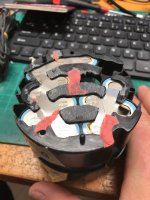You are using an out of date browser. It may not display this or other websites correctly.
You should upgrade or use an alternative browser.
You should upgrade or use an alternative browser.
Actual Test of Pure Nickel Heat?
- Thread starter rg12
- Start date
kdog
10 kW
I vidoed a test I did on a 10mm x. 2mm strip, ramped it up from 10-80amps. Unfortunately I couldn't upload it to the tube, my old phone couldn't do it. But it was bright red/yellow by 80amps and melting. I remember touching it at about 30 amps and burning my finger. I think it was just starting to glow at ~50amps. It was a while ago so I can't remember clearly. Strip was pure nickel, in open air, about 100mm long.
kdog said:I vidoed a test I did on a 10mm x. 2mm strip, ramped it up from 10-80amps. Unfortunately I couldn't upload it to the tube, my old phone couldn't do it. But it was bright red/yellow by 80amps and melting. I remember touching it at about 30 amps and burning my finger. I think it was just starting to glow at ~50amps. It was a while ago so I can't remember clearly. Strip was pure nickel, in open air, about 100mm long.
I need to know if a 3cm piece of pure nickel 6.75mm wide and 0.2mm thick can handle 7.8A without heating up...
DjSpaceGhost
100 mW
- Joined
- Mar 28, 2019
- Messages
- 41
A 7mm wide by .2mm thick strip of pure nickel can safely handle 9.5amps so I would say definitely so .
DjSpaceGhost said:A 7mm wide by .2mm thick strip of pure nickel can safely handle 9.5amps so I would say definitely so .
Is it 9.5A constant with no heat?
liveforphysics
100 TW
rg12 said:DjSpaceGhost said:A 7mm wide by .2mm thick strip of pure nickel can safely handle 9.5amps so I would say definitely so .
Is it 9.5A constant with no heat?
It's making heat, if it's enough to be a problem is a more complex question.
Nickel will be making ~4.1x the heat of copper of the same dimensions. The real question with setting up nickel spot welds isn't about getting the weld to work, but not causing cell damage.
liveforphysics said:rg12 said:DjSpaceGhost said:A 7mm wide by .2mm thick strip of pure nickel can safely handle 9.5amps so I would say definitely so .
Is it 9.5A constant with no heat?
It's making heat, if it's enough to be a problem is a more complex question.
Nickel will be making ~4.1x the heat of copper of the same dimensions. The real question with setting up nickel spot welds isn't about getting the weld to work, but not causing cell damage.
I will be using a 6.75mm wide 0.2mm thick nickel for constant current of about 6.5A
Will it not go hot enough while it's sitting on the cell holder plastic?
DjSpaceGhost
100 mW
- Joined
- Mar 28, 2019
- Messages
- 41
For some reason my response didn't post yesterday. It will not get hot enough to damage plastic cell holders at less than 7 amps.
DjSpaceGhost said:For some reason my response didn't post yesterday. It will not get hot enough to damage plastic cell holders at less than 7 amps.
Thanks alot
rg12 said:I will be using a 6.75mm wide 0.2mm thick nickel for constant current of about 6.5A
Will it not go hot enough while it's sitting on the cell holder plastic?
You will be just fine. Likely your nickel will be <10C above ambient temperatures at that current.
rg12 said:Thats super useful thanks alot
btw, for how long did you "stay" on each current for the test?
I did the test a couple years ago. It was either 5 or 10 minutes. Certainly long enough to heat soak the material.
Keep in mind that real world results will vary a little. This testing was done with the nickel in "open air" on both sides.
kdog
10 kW
In my mind temp is proportional to R, cross section and amps only (for a given environment ). Length doesn't affect temp. L affects total power dissipated bc it is related to R. So I don't think length is important for peak temp consideration. Sure, it's important when looking at total heat loss which is basically power dissipated, but X amps through Y cross-section should reach the same temp no matter the length. Voltage required would change hence power, but temp would be same.
Am I right?
Or wrong?
Am I right?
Or wrong?
izeman
1 GW
I have a super stupidly constructed 10s4p bottle battery, where ALL series connections are done with 7-8mm wide 0.15mm nickel strips.
Even though the max current draw should be around 12-15A, this is a lot of stress on the little nickel connections. Otherwise i don't know if it's worth it to weld another layer of nickel over the first one ...

Even though the max current draw should be around 12-15A, this is a lot of stress on the little nickel connections. Otherwise i don't know if it's worth it to weld another layer of nickel over the first one ...

Matador
100 kW
- Joined
- Jun 29, 2016
- Messages
- 1,045
flippy
1 MW
- Joined
- Aug 12, 2015
- Messages
- 2,351
Matador said:That is soo cool.
I'll add my table to this:Ampacity (Powestream extrapolation).jpg
In my table that same 0.8 mm wide x 0.15 mm thick pure nickel strip is rated 4.9A, which is about 5 degree celcius above room temp judging from your graph...
what is your derating factor? temperature? if so what themperature is that? the ratings seem "conservative"....
Matador
100 kW
- Joined
- Jun 29, 2016
- Messages
- 1,045
flippy said:Matador said:That is soo cool.
I'll add my table to this:Ampacity (Powestream extrapolation).jpg
In my table that same 0.8 mm wide x 0.15 mm thick pure nickel strip is rated 4.9A, which is about 5 degree celcius above room temp judging from your graph...
what is your derating factor? temperature? if so what themperature is that.
I extrapolated values from powerstream.com (thus used their specified derating, temps)
"Maximum amps for chassis wiring"
https://www.powerstream.com/Wire_Size.htm
This is meant to give some ballpark estimate as it is extrapolated, but it's quite conservative...
On the other hand the resistive values are exact (Ohms/meter for different specified strips of different specified metal types)...
So it's possible to calculate heat produced from ohm's law: Power (watts) = R x I^2,
where R (in milliohms) = resistivity (in milliOhms/meters* lenght of strip used (in meters).
The resistivity values are in red in the table.
The extrapolate ampacity are in blue in the table.
I initially made this as a guide for myself, but wanted to share with other (could not find anything better on the web). I'm a scientist but not a electrician though... Did my best
Matador
Matador
100 kW
- Joined
- Jun 29, 2016
- Messages
- 1,045
Here are my original excel files
View attachment Metal Strips Ampacity & Resistances by Matador.xlsx
View attachment Metal Strips Ampacity & Resistances by Matador.xlsx
Matador
100 kW
- Joined
- Jun 29, 2016
- Messages
- 1,045
So voltage drop, heat production all depend on resistance, gauge used, conductive metal type and lenght, for a given maximal tolerable voltage drop... is what I understand from all this....
How do we define what is an acceptable voltage drop for our EV application...
Is their a sort of consensus ? I was asking myself that but could not find an answer (well in real, I just didn't want the thing to cook and sag like hell when pulling amps).
Ex 0.02V drop max over a 10 cm conductor strip as an acceptable benchmark
How do we define what is an acceptable voltage drop for our EV application...
Is their a sort of consensus ? I was asking myself that but could not find an answer (well in real, I just didn't want the thing to cook and sag like hell when pulling amps).
Ex 0.02V drop max over a 10 cm conductor strip as an acceptable benchmark
flippy
1 MW
- Joined
- Aug 12, 2015
- Messages
- 2,351
voltage drop is not the metric one should focus on, temperature is key.
as long as the strip remains below 60ish degrees the standard aliexpress ABS cell holders and cell wrap wont lose strength or warp.
you can bump this a bit if you use that green paper rings as extra insulation.
personally i would not allow any part in my batteries get above 50c.
in the coming week i wiill be doing some temperature and high current tests with different sizes strip.
as long as the strip remains below 60ish degrees the standard aliexpress ABS cell holders and cell wrap wont lose strength or warp.
you can bump this a bit if you use that green paper rings as extra insulation.
personally i would not allow any part in my batteries get above 50c.
in the coming week i wiill be doing some temperature and high current tests with different sizes strip.
Matador
100 kW
- Joined
- Jun 29, 2016
- Messages
- 1,045
flippy said:voltage drop is not the metric one should focus on, temperature is key.
as long as the strip remains below 60ish degrees the standard aliexpress ABS cell holders and cell wrap wont lose strength or warp.
you can bump this a bit if you use that green paper rings as extra insulation.
personally i would not allow any part in my batteries get above 50c.
in the coming week i wiill be doing some temperature and high current tests with different sizes strip.
Cool. Looking forward to see your result...
Heat is not good indeed.
And if it heats up.. it means their is resistance. Which means voltage drop.
I tend to aim for the highest possible voltage a system (batt-controller-motor) can yield. Less sags means the same system will have a slight increase in power (P = V x I, where V (voltage) is bettery kept as high as possible, by minimizing voltage sag due to heating nickel strip conductor resistances)
Similar threads
- Replies
- 12
- Views
- 3,599
- Replies
- 7
- Views
- 873
- Replies
- 1
- Views
- 487
- Replies
- 0
- Views
- 537



